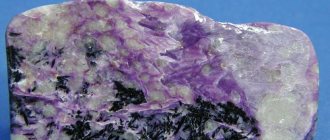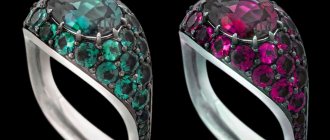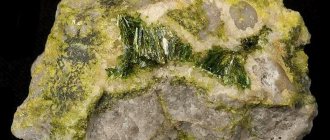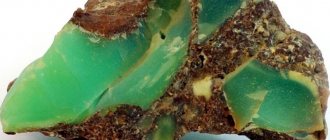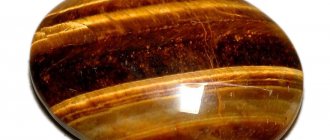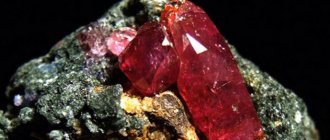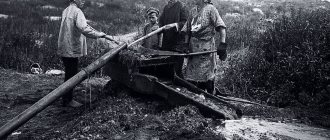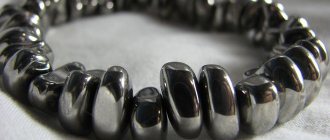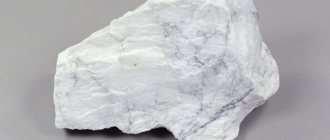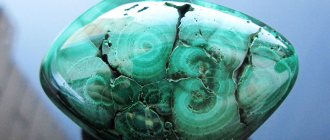| Category | Silicate minerals |
| Title in English | Bronzite |
| Formula | (Mg, Fe)Mg[Si2O6] |
| Group | Orthopyroxene group |
| Color | Greenish, Yellowish, Brown |
| Stroke color | Greyish, White |
| Shine | Metal, Pearl, Glass |
| Transparency | Opaque, Translucent, Transparent |
| singonia | Rhombic |
| Hardness | 5 — 6 |
| Cleavage | Average |
| Density, g/cm³ | 3,2 — 3,5 |
| Kink | Uneven |
| origin of name | Bronzite got its name due to the bronze reflection characteristic of the mineral. |
| Morphology | Bronzite produces coroprismatic crystals as well as irregularly shaped grains and massive dense aggregates. |
The mineral bronzite looks elegant and unusual in jewelry. It has a deep color and bright metallic luster, which sets it apart from many other stones. Flat plates or irregular ovals of bronzite are painted in various shades with transitions and inclusions. In addition, the physical and chemical properties of the stone make it possible to make a variety of beautiful products with it.
History and origin
The mineral itself has been known to researchers of igneous rocks for a long time. But it owes its name to the German mineralogist Dietrich Gustav Ludwig Karsten. Drawing attention to the striking similarity of the stone with slightly darkened bronze, Carsten called it bronzite, and under this name he included it in his own catalog of minerals in 1807.
Mineral – Bronzite
Physical properties
The mineral contains iron and manganese, the ratio of which affects the shades of the stone: from pure bronze to brownish-yellow or greenish. Depending on the conditions of formation, the gem has a granular or scaly structure. The latter looks like autumn leaves layered on top of each other. The gem is easy to polish.
| Property | Description |
| Formula | (Mg, Fe)Mg[Si2O6] |
| Hardness | 5,5 |
| Density | from 3.294 to 3.42 |
| singonia | Rhombic |
| Fragility | Fragile |
| Kink | Uneven |
| Cleavage | by (110) clear (angle 88°), by (010) and (100) imperfect (separate) |
| Shine | Metallic |
| Transparency | Transparent or opaque |
| Color | Greenish, yellowish or brown |
Physico-chemical characteristics of bronzite
The shape of bronzite crystals is usually represented by short-columnar prisms.
Irregularly shaped specimens and dense massive aggregates are also found. The color of the stone is due to the presence of manganese and iron impurities in its composition, which is expressed in brown, yellow-brown, greenish-brown shades. Bronzite is characterized by heterogeneous coloring, with the presence of various shades of the same color in one sample. In addition, the gem exhibits a bright bronze metallic sheen.
— Advertising —
Bronzite is opaque, sometimes small internal cavities are found in its specimens, due to which the “cat's eye” effect appears.
Hardness on the Mohs scale is 5-6. Specific gravity from 3.3 to 3.35 g/cm3. The crystals have average cleavage and have an orthorhombic system.
Varieties
In addition to the basic elements, bronzite contains “minor” ones, which, however, affect how the stone looks. Depending on the impurities, the mineral is divided into:
- calcium or limestone. Also known as jasper or lime;
- festin - interspersed with serpentine;
- morandite;
- aluminum bronzite.
This is interesting! In northern Kazakhstan, bronzite with inclusions of gold and copper is found, and in the American state of Montana - with admixtures of silver.
Types of bronzite
Industrial bronzite is a granular brown mass.
For jewelry purposes, specimens with a scaly structure, painted in golden, brown, green-brown or yellow, and other shades that look like bronze are used. Bronzite flakes are unique in their shape, and often resemble fallen autumn leaves. An interesting subspecies of jewelry bronzites are stones with rich green tints in color. These colors are characteristic of calcium (lime) bronzite. In the USA it is known as jasper bronzite, and in many other countries as lime bronzite (pictured).
Another variety of bronzite called festin is also popular among collectors. It contains inclusions of serpentine and has beautiful external qualities. This mineral exquisitely combines a rich, heterogeneous green color with the faint shine of the stone’s scales.
Medicinal properties
Lithotherapists claim that bronze is not only a beautiful stone, but also a healing stone. Its energy is used to treat and prevent a number of ailments.
So, according to lithotherapists, constantly wearing the mineral will help get rid of dermatitis, reduce the manifestations of eczema and psoriasis, and speed up their healing.
It is also believed that the mineral affects the functioning of the sebaceous glands, regulating and normalizing them, helping to reduce acne and reduce the risk of acne. Therefore, it is recommended to be worn by teenagers.
Stone bracelet
Bronzite can also bring significant benefits to those who have problems with the thyroid gland. To reduce the size of the goiter and prevent re-inflammation of the thyroid gland after therapy or surgery, lithotherapists advise wearing pendants, necklaces or beads with this gem.
The gem is also used as an antiviral agent, or more precisely, as additional protection against colds and flu. It is believed that the stone protects its “carrier” from all kinds of viruses, even during the season of their increased activity.
Also read: Heliotrope - the importance of the mineral for humans
In addition, bronzite normalizes blood pressure and helps get rid of headaches.
Important! Among other things, the gem is able to influence the human nervous system, helping to fight depression and anxiety. During observations, it was found that people who have jewelry or accessories with bronzite cope with stress much more easily and endure difficulties and failures more calmly.
Magic properties
Bronzite is also a real magical stone that can affect not only the health of its owner, but also most aspects of his life.
One of the abilities of the mineral is the ability to attract money and other material values. Therefore, the gem will become an indispensable assistant for those who have stable financial problems. Having “settled” bronzestone in your home (in the form of jewelry or any decorative items made from a natural gem), you can soon feel the effect of the mineral.
At the same time, the monetary increase can be different: from a promotion with an increase in salary - to income from the most unexpected sources, for example, an unexpected inheritance, an old and long-forgotten debt, or even an amazing find.
In parallel with the increase in income, bronzite will definitely “teach” how to spend money correctly and help get rid of unnecessary and unnecessary expenses.
Other magical properties of bronzite include cleansing thoughts from negativity and replenishing energy.
In addition, it helps to avoid conflict situations, for which the mineral is nicknamed the “stone of politeness” and to find the right solution in any, even the most difficult situations. It is thanks to these abilities that jewelry with a bronze-colored stone is recommended to be worn by all media persons and those whose work involves constant communication.
Among those for whom the stone is suitable as a talisman:
- medical workers who, with its help, will be able to “see” the diagnosis more clearly;
- managers;
- psychologists;
- journalists;
- secretaries.
And of course, bronzite will provide invaluable assistance in family relationships, especially if they do not go well for some reason.
Note! The stone is able to protect its “owner” from the evil eye and damage, returning all the negativity to the one who sent it.
Crystal optical properties in thin preparations (sections)
In transmitted light in thin sections it is colorless or very weakly colored - pinkish, brownish. Pleochroism is usually almost invisible, sometimes slightly pleochroic - from yellowish, light pink or green in Ng, to light greenish, red-brown and violet in Np. Biaxial, usually (—), less often (+). The extinction is straight, rarely oblique (3-5°). Extension (+). The plane of the optical axes (010). ng = 1.673–1.715, nm = 1.667–1.697, np = 1.661–1.692, ng – np = 0.008–0.015. The dependence of the refractive index values on the iron content is not clearly expressed. 2V from (+) 80-85° to (-)73-87° (the latter values are more typical). The value 2V = 90° approximately corresponds to a content of about 14% FeSiO3, according to Vinchel. There is no dispersion of the optical axes at 2V around 90°, weak r > v at negative values of 2V. Thin plates of decomposition of solid solutions of augite, diopside, hypersthene, and clinobronzite are observed in thin sections. Fine polysynthetic twinning and deformation structures are often observed.
Compatibility with other stones
In order for a gem to fully reveal its potential, “bestow” the one who wears it and give it its protection, it is necessary to wear it separately from other minerals, or to choose the right neighborhood for it.
Bronzite is considered the stone of the Sun. And the influence of this celestial body determines the relationship of the stone with other minerals.
Thus, in jewelry it goes well with other “sunny” stones, such as amber, hyacinth, and heliodor.
Bronzite will also “feel” good in the vicinity of stones of Mars and Jupiter, including jasper, hematite, lapis lazuli, and aquamarine.
Bronzite is combined with minerals under the auspices of the Moon, Venus and Mercury:
- malachite;
- opal;
- apatite;
- coil;
- beryl.
Also read: Bull's eye - a symbol of good health
But in these cases, the compatibility of the mineral with other gems will depend on a number of circumstances, including the “carrier” itself, its zodiac and ruling planet.
But according to astrologers and esotericists, bronzite is completely incompatible with the minerals of Saturn - jade, chalcedony, dark topaz, agate.
In addition, according to Indian Vedic culture, you should not combine this mineral with stones ruled by Rahu (hessonite) and Ketu (cat's eye).
Description
Natural bronzites occur in the form of small plates or irregular ovals. They contain noticeable inclusions of a greenish color. If these spots are removed and the mineral is processed using a special technique, the stone will be very similar to an ingot of gold alloy.
The color of an opaque stone depends on the ratio of elements. There are several main types:
- brown mineral;
- brown;
- olive;
- bronze;
- golden.
Calcium and serpentine are found as inclusions in bronzite. The calcium found in the mineral gives it a beautiful light green color, for which it is called lime stone. Bronzite with serpentine additives is highly valued. This is an incredibly beautiful emerald-colored gem with light bronze flakes.
Its beauty, high strength and ease of processing have made the mineral a favorite of jewelers. Bronzite is used to make durable tabletops, vases, figurines, and even floor tiles.
Jewelry with mineral
The use of the gem, called bronzite, can be different: industrial and jewelry. The industry uses a granular brown mineral. And stones with a scaly structure and warm color shades are perfect for making jewelry.
Most often, gems are inserted into pendants and rings. Less commonly, due to the significant weight of the stone, it is used in the manufacture of earrings. The processed mineral is also used to make bracelets, beads, necklaces, and key chains.
Beads
When processing the stone, its main part is given a rounded shape, which allows you to demonstrate all the splendor of the mineral and convey all the facets of its shades.
Silver is mainly used as a setting for bronzite, although jewelry with gold is also found.
- The cost of the processed bronzite itself is not very high - the price for medium-sized beads varies from 80-150 rubles. Ready-made bracelets made from elements of the same size will cost 680-800 rubles.
- As for other jewelry, a lot depends on the frame. For example, a silver-plated ring with a small bronzite insert can be bought for 1,200, and a necklace made of bronzite and smoky quartz for 1,500 rubles.
Branches of application of bronzite
Gem-quality bronzes are widely used in jewelry.
When cut into cabochons, they are used as inserts in various jewelry. The stone looks great in light metal frames, which highlight its bronze shimmer. Bracelets, beads, pendants, rings, and earrings are made from bronzites. All shades of bronzite appear best when processed in a rounded form, and its medium degree of hardness makes cutting and polishing a fairly simple process. Buyers like the unusual appearance and relatively low cost of the stone, and jewelers value broznit for its versatility and ease of processing. In addition to jewelry, bronzites are used to make various crafts and souvenirs. A vase, box or candlestick made of bronzite also looks great.
Moreover, even countertops, statues and floor tiles are made from bronzite, as it has a very low wear rate.
Finally, bronzite amulets and talismans are popular, used by doctors and everyone who wants to get rich.
How to distinguish a fake?
Astrologers and esotericists warn that only natural stone has magical and healing properties. And in jewelry, natural bronzite looks much more impressive and original.
Unlike most stones, bronzite is not currently synthesized in the laboratory, so it is impossible to find an artificially grown mineral on sale. Glass and plastic are a completely different matter. Despite the not very high price of the mineral, its glass and plastic “analogues” are even cheaper, which is why they are found on sale.
A mineralogist is guaranteed to recognize the “glass”. However, there are several signs that will help you distinguish a real stone from a fake at home.
- Natural stones heat up very slowly, even when held tightly in your fist.
- Products made from natural materials are much heavier than those made from glass and especially plastic. Any natural stone will help you navigate by weight.
- Each gem is individual, like a person’s fingerprints. To understand how unique the design of a particular stone is, it is enough to compare it with those that lie nearby. If the designs in all cabochons or beads inserted into earrings, necklaces or bracelets are identical, then the products consist of fake bronzites.
Another sign is small inclusions and zoning. They are found even in the highest quality minerals. You can examine them with a magnifying glass.
Also read: Chalcedony - an ancient Greek miracle from the coast of the Sea of Marmara
The difference between fake and original
Despite the relatively low price, fake gemstones are often found on the market. This is glass or polymer plastic. You need to consult a mineralogist to identify a fake. Knowing only a few features of the stone, buyers can determine the cheapest visit.
Natural minerals have the following characteristics:
- Low heat capacity. In warm weather, stones are cold to the touch. It warms up slowly when exposed to sunlight and body temperature.
- High density and weight. These were much heavier things, such as natural minerals such as plastic and glass.
- A unique picture. Real stones are different. Samples obtained from the same area also have different shades and inclusions. If all the minerals in a batch are identical, they are probably counterfeit.
Assessing the quality of a stone is best done using a magnifying glass. This way you can see the mineral pattern in more detail. In addition, the inspection should be carried out under both natural and artificial lighting.
How to wear and care instructions
Bronzite practically does not wear out and retains its attractiveness for a long time. However, jewelry with stone still requires care.
Despite its resistance to external negative factors in the form of acids, UV rays, water and temperature changes, the stone is quite soft, so it is recommended to store it separately from other minerals and jewelry. The best option would be to place the bronzite in a soft bag or box.
In order for the jewelry to have a luxurious look, the mineral is periodically polished with a piece of felt or suede.
If the stone is very dirty, it is washed in a solution of water and liquid soap.
Important! Under no circumstances should you use caustic household chemicals, abrasive materials or hard brushes for washing. In addition, before starting household chores (washing, cleaning, cooking), remove all jewelry.
The gem requires not only external cleaning - from time to time it is necessary to cleanse its energy. To do this, place the stone next to the rock crystal for a while.
Mining and stone processing
Mineral deposits are located in the form of layers or rounded accumulations of ore. The largest stone deposits are located in the Urals. It has been mined there for more than 500 years.
Also, voluminous deposits of the mineral were found:
- in USA;
- Australia;
- Sweden;
- Portugal;
- Austria.
Small deposits are also located in Germany, India, and Brazil.
Traditionally, stone is processed, cut and polished in the region where it was mined. The mineral is given a rounded shape. This way all the highlights and shimmers are revealed most fully. Also, during processing, some craftsmen clean the gem from green inclusions. As a result, it has a yellow-gold hue.
Watch the video to see what the processed stone looks like:
Compatibility with names and zodiac signs
(“+++” – the stone fits perfectly, “+” – can be worn, “-” – is strictly contraindicated):
| Zodiac sign | Compatibility |
| Aries | + |
| Taurus | — |
| Twins | + |
| Cancer | + |
| a lion | +++ |
| Virgo | + |
| Scales | + |
| Scorpion | + |
| Sagittarius | + |
| Capricorn | — |
| Aquarius | + |
| Fish | + |
Bronzite will fully reveal its astrological properties if its owner was born under the sign of Leo. It is this zodiac sign that will receive the maximum benefit from using the stone. Bronzite will give Leos maximum health, wealth and good luck. In addition, the stone will allow those born under this sign to reveal their hidden talents.
Aquarius, Pisces, Gemini, Cancer, Virgo, Libra, Scorpio and Sagittarius can use the gem as a talisman and talisman. But the stone will have less impact on them.
But the mineral is contraindicated for Taurus and Capricorn. It will have the opposite effect on them: it will upset the emotional balance, worsen their well-being and attract all the troubles that are possible.
As for names, the stone has a special meaning for a person named Stanislav.
Is this stone right for you?
Artificial production of mineral
Orthorhombic pyroxenes with iron content corresponding to bronzite were synthesized at a temperature of 800-850° and a pressure of 1000 kg/cm2.
Diagnostic signs
Similar minerals . Enstatite, hypersthene.
It differs from more ferruginous rhombic pyroxenes in its lighter color, in transparent thin sections - colorlessness, a pinkish tint of color, and very weak pleochroism; from magnesian (enstatites) - a pinkish tint of color, weak pleochroism; from both - by intermediate values of refractive indices, optical sign (+) and 2V about 90°. From monoclinic pyroxenes - direct extinction, composition, unit cell parameters.
Associated minerals. Olivine, enstatite, diopside, serpentine, chromite, magnetite, etc.
Interesting things about the stone
In addition to the usual variants of bronzite, there are also completely original specimens in nature. Thus, golden-yellow minerals were discovered on the island of Sri Lanka. They differ from their “brothers” in greater transparency.
Bronzes are found not only on Earth, but also on the Moon. Instances of lunar minerals with similar properties were delivered among samples from the Luna 20, Apollo 14 and Apollo 16 stations. A distinctive feature of lunar minerals is their high content of chromium and titanium.
When all the greenish inclusions are removed from the gem, bronzite becomes virtually indistinguishable from the gold alloy.
5/5 — (2 votes)
Chemical composition
Bronsites include orthorhombic pyroxenes with FeO from 5 to 13%, according to Strunz (1970), and from 6.50 to 16.0%, according to Dear et al. (1965). In natural bronzites, the amount of FeO may exceed accepted limits, but nevertheless, based on other properties, the mineral is diagnosed as bronzite, and, conversely, the FeO content may correspond to bronzite, and the mineral is determined as enstatite or hypersthene. The MgO content ranges from 30.5% to 22% and is inversely related to FeO. The SiO content, 51.00–55.00%, is mainly correlated with Al2O3. Al2O3 content from 0.42 to 12.0 (usually less than 1.5%).
They are characterized by an Al2O3 content of 2.0–4.0% from deep inclusions of ultrabasic rocks in kimberlites, less often in effusive rocks; higher levels (4–6% to 12%) are observed in bronzites of high-alumina metamorphic rocks and alkaline basalts. A mineral containing more than 2% Al2O3 is called aluminum bronzite. Other components: Fe2O3 - up to 2.0%, rarely higher; CaO - from 0.5 to 3.5% (usually 1.0-1.5%, at higher contents the presence of inclusions of calcium monoclinic pyroxenes is assumed); MnO - up to 0.4%, TiO2 - up to 0.45%, rarely up to 1.3%; Cr2O3 - up to 0.3%, sometimes up to 0.6%. Increased concentrations of TiO2 and Cr2O3 are characteristic of bronzites from lunar rocks. Na and K are not always established in bronzites; the Na2O content does not exceed 0.4, and K2O - 0.04%. Some minerals contain up to 0.01% P2O5. The usual H2O+ content is 0.3-0.5%, sometimes up to 1.4%; the H2O_ content fluctuates within the same limits. Occasionally, fluorine is observed in bronzites (about 0.08%), for example, in bronzite from the gabbro-norite pegmatite Nittis (Kola Peninsula). In bronzite from bronzite veins in the anorthosite massif of the Dzhugdzhur Range. (Okhotsk coast, Russia) 0.07% V2O3 was established. Spectral analysis in bronzite from ultrabasic rocks of the Middle Bug region determined (in%): Cr 0.055-0.15, Co 0.005-0.007, Ni 0.034-0.038. Bronzite from pyroxenite and gabbro of Monchetundra (Kola Peninsula) contains 0.003% ZrO2. Bronzite from rocks of gold deposits in Northern Kazakhstan contains Cu and Au. Rocks from the ultramafic zone of the Stillwater complex (Montana, USA) contain an excess amount of Ar40, which is associated with its accumulation during primary crystallization.
Crystallographic characteristics
system .
Class. Rhombo-bipyramidal. Axle ratio. 2.062: 1: 0.588.
Form of bronzite in nature
The crystal structure, polymorphism pattern, crystal shape and twinning are similar to those of enstatite.
Aggregates. Elongated and short prismatic crystals, grains, granular masses, microlites.
In bronzite individuals, plates of monoclinic and orthorhombic pyroxenes are often observed, parallel to (100) bronzite, which are considered to be products of solid solution decomposition. As shown by X-ray, electron microscopy and microprobe studies, bronzite with the composition Mg0.81Fe0.16 Ca0.03SiO3 from the Stillwater complex (Montana) contains plates 0.5 μm thick, composed of augite with 24% CaO; they account for up to 1.4% of the grain volume. Clinopyroxene plates (with 19.7% CaO) 3–10 µm thick are set in bronzite (FeO 10.6%, CaO 1.2%) from olivine pyroxenite of the Kibi Plateau in Southwestern Japan. In lunar samples and meteorites, decay plates are observed that correspond in properties to clinobronzite. In a mineral with Fs 20% from the anorthosite massif of the Dzhugdzhur Range. Hypersthene plates with Fs 43% were identified as a product of solid solution decomposition. In stone from heavily deformed and partially metamorphosed gabbro of Central Australia, diopside plates located along (100) bronzite and kink bands composed of clinoenstatite, which arose under the action of deformation stresses, were noted. In lunar KREEP basalts (Apollo 14), a regular growth of twinned magnesian pigeonite was observed on bronzite along the (100) plane. Myrmekite intergrowths of bronzite with ilmenite are found in rocks of the lower zone of the Skergard intrusion (East Greenland) and in a sample of lunar breccia (Apollo 16). Symplectite intergrowths of bronzite and magnetite surrounding or completely replacing olivine grains occur in the mafic rocks of the layered Wateranga intrusion in Australia. In many crystals from the gabbro-norite pegmatite of Mount Nittis in Monchetundra (Kola Peninsula), thin hair-like cracks are filled with mineral/diopside sulfides. Bronzite in pyrope-bronzite-sillimanite crystalline schists of the Stanovoy Range forms thin intergrowths with sillimanite. In the rock from the lunar microbreccia (Apollo 14), inclusions of rutile crystals were observed, oriented parallel to the c-axis.
